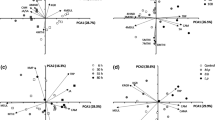Abstract
Hydroxamic acids (Hx) are natural products of Gramineae that are associated with cereal resistance to pests. We aimed at characterizing the induction of Hx accumulation in seedlings of wheat,Triticum aestivum, by short-term infestation of the cereal aphid,Rhopalosiphum padi. A load of 25 aphids increased significantly the Hx levels in the infested primary leaf in comparison with control levels. Lower loads did not increase Hx concentration. Aphid infestation lasting 16 hr did not elicit induction of Hx, even after a time-lag of 32 hr to allow the expression of any induced response. Forty-eight hours was the minimum duration of aphid infestation required to trigger Hx induction. The age of the infested tissue (the primary leaf) did not affect induction. Similar increases of Hx were found in unfolding, expanding, and totally expanded primary leaves. It was determined that the regime of nutrient supply (N-intensive nutritive solutions at low and high concentration) to wheat seedlings had no effect on the magnitude of the aphid-induced Hx (N-based secondary metabolites). Results obtained are discussed in the framework of general theories of plant defense allocation.
Similar content being viewed by others
REFERENCES
ARGANDOÑA, V. H., NIEMEYER, H. M., and CORCUERA, L. J. 1981. Effect of content and distribution of hydroxamic acids in wheat on infestation bySchizaphis graminum.Phytochemistry 20:673–676.
BALDWIN, I. T. 1989. The mechanism of damage-induced alkaloids in wild tobacco.J. Chem. Ecol. 15:1661–1680.
BALDWIN, I. T., SIMS, C. L., and KEAN, S. E. 1990. The reproductive consequences associated with inducible alkaloidal responses in wild tobacco.Ecology 71:252–262.
BRYANT, J. P., CHAPIN, F. S., and KLEIN, D. R. 1983. Carbon/nutrient balance of boreal plants in relation to vertebrate herbivory.Oikos 40:357–368.
BRYANT, J. P., and JULKUNEN-TIITTO, R. 1995. Ontogenic development of chemical defense by seedling resin birch: energy cost of defense production.J. Chem. Ecol. 21:883–896.
COLEMAN, J. S., and JONES, C. G. 1991. A phytocentric perspective of phytochemical induction by herbivores, pp. 3–46,in D. W. Tallamy and M. J. Raupp (eds.). Phytochemical Induction by Herbivores. John Wiley & Sons, New York.
EDWARDS, P. J., WRATTEN, S. D., and PARKER, E. A. 1992. The ecological significance of woundinduced changes in plants: insect grazing and plant competition.Oecologia 91:266–272.
ENGLISH-LOEB, G. M., KARBAN, R., and HOUGEN-EITZMAN, D. 1993. Direct and indirect competition between spider mites feeding on grapes.Ecol. Appl. 3:699–707.
FRISCHKNECHT, P. M., BÄTTIG, M., and BAUMANN, T. W. 1987. Effect of drought and wounding stress on indole alkaloid formation inCatharanthus roseus.Phytochemistry 26:707–710.
GIANOLI, E., and NIEMEYER, H. M. 1996. Environmental effects on the induction of wheat chemical defences by aphid infestation.Oecologia 107:549–552.
GIANOLI, E., and NIEMEYER, H. M. 1997. Lack of costs of herbivory-induced defenses in a wild wheat. Integration of physiological and ecological approaches.Oikos 80, In press.
GIANOLI, E., and NIEMEYER, H. M. 1998. Allocation of herbivory-induced hydroxamic acids in the wild wheat,Triticum uniaristatum.Chemoecology In press.
GIANOLI, E., PAPP, M., and NIEMEYER, H. M. 1996. Costs and benefits of hydroxamic acids-related resistance in winter wheat against the bird cherry-oat aphid,Rhopalosiphum padi (L.)Ann. Appl. Biol. 129:83–90.
GIANOLI, E., CAILLAUD, C. M., CHAUBET, B., DI PIETRO, J. P., and NIEMEYER, H. M. 1997. Variability in grain aphidSitobion avenae (F.) (Homoptera: Aphididae) performance and aphidinduced phytochemical responses in wheat.Environ. Entomol. 26:638–641.
GIBBERD, R., EDWARDS, P. J. and WRATTEN, S. D. 1988. Wound-induced changes in the acceptability of tree foliage to Lepidoptera: within-leaf effects.Oikos 51:43–47.
HARTLEY, S. E., and FIRN, R. D. 1989. Phenolic biosynthesis, leaf damage and insect herbivory in birch (Betula pendula).J. Chem. Ecol. 15:275–283.
HAYASHI, H., and CHINO, M. 1986. Collection of pure phloem sap from wheat and its chemical composition.Plant Cell Physiol. 27:1387–1393.
JOHNSON, N. D., RIGNEY, L. P., and BENTLEY, B. L. 1989. Short-term induction of alkaloid production in lupines. Differences between N2-fixing and nitrogen-limited plants.J. Chem. Ecol. 15:2425–2434.
KARBAN, R. 1991. Inducible resistance in agricultural systems, pp. 402–420,in D. W. Tallamy and M. J. Raupp (eds.). Phytochemical Induction by Herbivores. John Wiley & Sons, New York.
KOWALSKI, R., and VISSER, P. E. 1987. Changes of free aminoacids in the leaves ofTriticum aestivum and their implications for the assessment of plant/insect interactions.J. Plant Dis. Prot. 94:161–168.
MANUWOTO, S., and SCRIBER, J. M. 1985. Consumption of experimentally altered corn by southern armyworm: Iron, nitrogen, and cyclic hydroxamates.J. Chem. Ecol. 11:1469–1483.
MCKEY, D. 1974. Adaptive patterns in alkaloid physiology.Am. Nat. 108:305–320.
NIEMEYER, H. M. 1988. Hydroxamic acids (4-hydroxy-1,4-benzoxazin-3-ones), defence chemicals in the Gramineae.Phytochemistry 27:3349–3358.
NIEMEYER, H. M., and PÉREZ, F. J. 1995. Potential of hydroxamic acids in the control of cereal pests, diseases and weeds, pp. 260–269,in Inderjit, K. M. M. Dakshini, and F. A. Einhellig (eds.). Allelopathy. Organisms, Processes, and Applications. ACS Symposium Series 582, Washington, D.C.
NIEMEYER, H. M., PESEL, E., COPAJA, S. V., BRAVO, H. R., FRANKE, S., and FRANCKE, W. 1989. Changes in hydroxamic acids levels of wheat plants induced by aphid feeding.Phytochemistry 28:447–449.
OHNMEISS, T. E., and BALDWIN, I. T. 1994. The allometry of nitrogen allocation to growth and an inducible defense under nitrogen-limited growth.Ecology 75:995–1002.
RHOADES, D. F. 1979. Evolution of plant chemical defense against herbivores, pp. 3–54,in G. A. Rosenthal and D. H. Janzen (eds.). Herbivores: Their Interaction with Secondary Plant Metabolites. Academic Press, Orlando.
ZADOKS, J. C., CHANG, T. T., and CONSAK, C. F. 1974. A decimal code for the growth stage of cereals.Weed Res. 14:415–421.
ZANGERL, A. R. 1990. Furanocoumarin induction in wild parsnip: Evidence for an induced defense against herbivores.Ecology 71:1926–1932.
ZANGERL, A. R., and BAZZAZ, F. A. 1992. Theory and pattern in plant defense allocation, pp. 363–391,in R. S. Fritz, and E. L. Simms (eds.). Plant Resistance to Herbivores and Pathogens. Ecology, Evolution and Genetics. University of Chicago Press, Chicago.
ZANGERL, A. R., and BERENBAUM, M. R. 1995. Spatial, temporal and environmental limits on xanthotoxin induction in wild parsnip foliage.Chemoecology 5/6:37–42.
Author information
Authors and Affiliations
Rights and permissions
About this article
Cite this article
Gianoli, E., Niemeyer, H.M. Characteristics of Hydroxamic Acid Induction in Wheat Triggered by Aphid Infestation. J Chem Ecol 23, 2695–2705 (1997). https://doi.org/10.1023/A:1022554708782
Issue Date:
DOI: https://doi.org/10.1023/A:1022554708782




